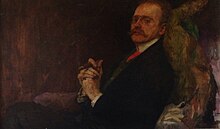Johann Strauss Theater
The Johann Strauss Theater in Vienna - Wieden was built as an operetta theater in 1908 at the height of the economic success of the Viennese operetta . The architect Eduard Prandl provided the building with Baroque forms. Its auditorium held 1200 people.

painting by Moritz Coschell
history
The theater in Favoritenstrasse 8 opened on October 30, 1908 with 1001 Nights , an adaptation of the operetta Indigo and the 40 Robbers by Johann Strauss (son) that was created after the composer's death .
Here, among other things, the world premiere and over 500 other performances of Emmerich Kálmán's Die Csárdásfürstin (1915) took place. Alexander Girardi was a regular guest in Kálmán's The Gypsy Primate (1912). In 1925 the world premiere of Franz Lehárs Paganini took place . In March 1928 Josephine Baker appeared here with the Revue Black on White , after the Ronacher had previously been banned from performing because it only had a license as a variety theater, which is why the resourceful managers rented the Johann Strauss Theater, which had a license for Revue and operetta owned.
The composer Richard von Goldberger wrote a number of successful operettas, including Der Zauberknabe (1900) and other performances.
As a result of the Great Depression in 1929 and the advance of the sound film , the theater ran into financial difficulties. In 1931, the building, located close to the center in the Wieden district, was therefore converted by the architect Carl Witzmann (1883–1952) into a 1400-person cinema called Scala (opening: September 30, 1931), which was also used for variety shows.
Between 1948 and 1956, theater was played again under the patronage of the Soviet occupying power . The New Theater in der Scala offered artistically highly ambitious plays with a first-class cast (e.g. with Karl Paryla and Therese Giehse ), which were boycotted by the Viennese critics for mainly political reasons ( Vienna Brecht boycott ). Propaganda pieces such as Ernst Fischer's play The great betrayal directed against Josip Broz Tito were also performed.
After the Soviet occupation forces withdrew, the theater continued to exist for a short time; the last performance took place on June 30, 1956. 1959–1960 the theater was torn down and thus the first victim of a theater death, which also fell victim to the Viennese Citizens' Theater and the Vienna City Theater . Decades later, the vacant lot was closed by a residential building by the municipality of Vienna. In the meantime unsuccessful demands for the design of a park had been made.
World premieres
- Boy or girl , operetta by Bruno Granichstaedten , on November 13, 1908
- The Prince's Child , operetta by Franz Lehár , October 7, 1909
- The Gypsy Primas , operetta by Emmerich Kálmán , on October 11, 1912
- The night express train , operettas by Leo Fall , on December 20, 1913
- The stupid heart , operetta by Carl Michael Ziehrer , on February 27, 1914
- All about love , operetta by Oscar Straus , on November 9, 1914
- Die Csárdásfürstin , operetta by Emmerich Kálmán, on November 17, 1915
- The carnival fairy , operetta by Emmerich Kálmán, on September 21, 1917
- Das Hollandweibchen , operetta by Emmerich Kálmán, on January 30, 1920
- A summer night , operetta by Robert Stolz , on December 23, 1921
- Bajazzo's Adventures , operetta by Michael Krasznay-Krausz , 1923
- A fairy tale from Florence , operetta by Ralph Benatzky , on September 14, 1923
- Paganini , operetta by Franz Lehár, October 30, 1925
- Evelyne , operetta by Bruno Granichstaedten , on January 6, 1928
- The Violet from Montmartre , operetta by Emmerich Kálmán, on March 21, 1930
- The sweetest hoax in the world , operetta by Robert Stolz, on December 21, 1937
literature
- Dieter Klein , Martin Kupf , Robert Schediwy : Stadtbildverluste Wien. A look back over five decades. 3. Edition. Lit, Vienna 2005, ISBN 3-8258-7754-X .
Web links
Individual evidence
- ^ Wiener Zeitung of October 30, 1908
- ^ Hugo Wiener : Zeitensjünge. Memories of an old youth . Ullstein book, volume 35441, ZDB ID 255248-6 . Ullstein, Frankfurt (inter alia) 1994, ISBN 3-548-35441-6 , p. 79.
- ↑ The new Scala sound film palace. In: Neue Freie Presse , Morgenblatt, No. 24082/1931, September 30, 1931, p. 9, top right. (Online at ANNO ). .
Coordinates: 48 ° 11 ′ 43.4 " N , 16 ° 22 ′ 6.6" E
